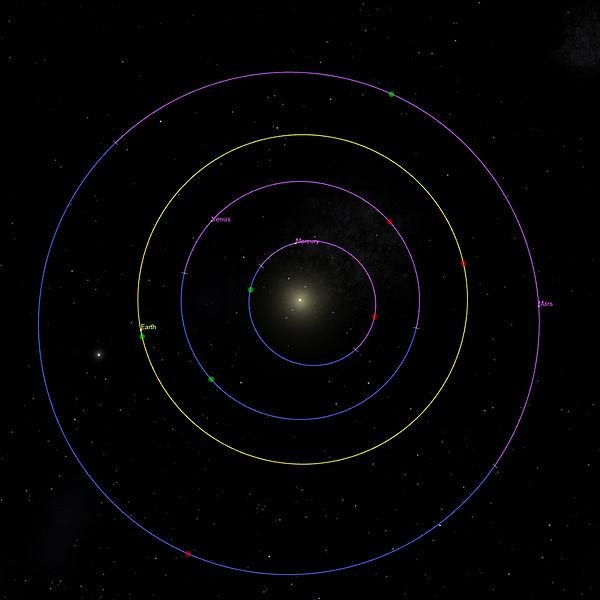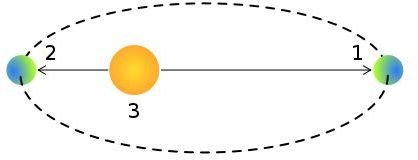What Happens at Perihelion and Aphelion?
Characteristics of an Elliptical Orbit
Most of the celestial bodies in the Solar System, including the planets, orbit around the Sun in more or less elliptical orbits. The term perihelion refers to the closest point to the Sun in an object’s elliptical orbit (point 2 of the image), and the term aphelion refers to the furthest point from the Sun (point 1 of the image). The object may be a planet such as the Earth, a satellite or another celestial body. Both terms have Greek roots, ‘helios’ means the Sun, ‘peri’ means close to and ‘apo’ means away from.
Due to the fact that Earth orbits the Sun in an almost circular orbit, the Sun is close to the center of the orbital path. This makes the distance variation of the two points, aphelion and perihelion, very small compared to the distance variations of other planets. More specifically, when the Earth reaches the perihelion around January the 3rd, it is 91,445,000 miles (147,166,462 km) away from the Sun. On the other hand, when the Earth reaches aphelion around July the 4th, it is only 94,555,000 miles (152,171,522 km) away from the Sun. This makes the average distance from the Sun to around 93 million miles.
Another important fact is that a planet or a satellite moves more slowly at aphelion and more quickly at perihelion according to Kepler’s 2nd Law. When the Earth is at aphelion its potential energy is at its maximum and its kinetic energy is at its minimum. The opposite happens when the Earth is at perihelion. The potential energy is minimum and the kinetic energy is maximum. The whole phenomenon results in a slight difference in duration between the summers of the two hemispheres_;_ Northern Hemisphere’s summer is 2 to 3 days longer than the Southern Hemisphere’s summer_._
Apart from perihelion and aphelion, there are more general terms that describe the furthest and the nearest point of an elliptical orbit. These are the apoapsis or apicenter and the periapsis or pericenter of the orbit respectively. When referring to the Earth, the closest point is called perigee and the furthest point is called apogee. For a more detailed explanation on the two Earth-related terms visit the article: “Apogee and Perigee - The Near and Far of Orbits”.
Perihelion and Aphelion Distances of the Planets
Almost all of the Solar System’s planets follow more elliptical orbits than the Earth. The most eccentric orbit belongs to Pluto (although it is no longer considered a planet). The variation is so evident, that Pluto is sometimes closer to the Sun than Neptune is_._
The first number below indicates the perihelion distance of the planet, while the second number indicates the aphelion distance in Astronomical Units - AU. The unit of AU is the average distance from the Earth to the Sun—93 million miles or 150 million kilometers.

Mercury: 0.31AU - 0.47AU
Venus: 0.718AU - 0.728AU
Earth: 0.98AU - 1.02AU
Mars: 1.38AU - 1.67AU
Image: Orbits of the inner planets.The green dot depicts the perihelion and the red dot the aphelion of each planet.
Jupiter: 4.95AU - 5.45AU

Saturn: 9.02AU - 10.0AU
Uranus: 18.3AU - 20.1AU
Neptune: 30.0AU - 30.3AU
Pluto: 29.7AU - 49.9AU
Image: Orbits of the outer planets.The green dot depicts the perihelion and the red dot the aphelion of each planet.
Effects on the Succession of Seasons
Although the Earth’s distance from the Sun varies during the passing from aphelion to perihelion, it is wrongly believed that this fact causes the succession of seasons. People tend to believe that when the Earth is at aphelion, it is winter and when the Earth passes from perihelion, it is summer. This distance variation is not adequate to affect the climate of the planet to the degree we experience.
Seasons are actually the result of the Earth’s axial tilt. As the Earth travels along its orbital path, the hemisphere that happens to tilt toward the Sun experiences summer, the other hemisphere that is titled away, experiences winter. After six months, the two hemispheres exchange their roles, making the succession of seasons a perpetual process. The seasons are driven by the amount of direct sunlight the surface of the Earth receives.
Things would be rather different, if Earth had a different shaped orbit around the Sun. For example, in the case of Mercury where perihelion is 28 million miles away from the Sun and aphelion 44 million miles away. Such huge changes during the year would make the existence of life as we know it, difficult on the planet.
Sources:
- windows2universe.org
- science.nasa.gov
- spaceweather.com
Images:
- Perihelion and Aphelion by Pearson Scott Foresman
- Inner Planet Orbits by Danial79
- Outer Planet Orbits by Danial79
